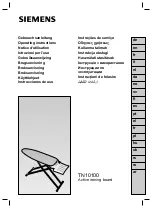
LabWindows/CVI Release Notes for Windows
24
©
National Instruments Corporation
Changes to Existing Functions
For
GetPrintAttribute
and
SetPrintAttribute
, the last parameter is the attribute
value. In previous versions of LabWindows/CVI, this is an integer. Now the parameter is a
variable type argument. This change does not require any modifications to your source code.
The attribute
ATTR_FLOATING
has the following new constants:
The constant
VAL_FLOAT_APP_ACTIVE
specifies to make the panel floating, or topmost,
only when the application is active. The constant
VAL_FLOAT_ALWAYS
maintains the panel
as floating or topmost even when the application is not active.
When LabWindows/CVI displays a popup panel, such as when you call
FileSelectPopup
or
InstallPopup
, all LabWindows/CVI panels with the
ATTR_FLOATING
attribute set to
either
VAL_FLOAT_APP_ACTIVE
or
VAL_FLOAT_ALWAYS
do not float while the popup is
displayed. In previous versions of LabWindows/CVI, a floating window can cover the popup
window, preventing an interaction with the popup window.
LoadPanel
,
LoadPanelEx
,
LoadMenuBar
, and
LoadMenuBarEx
now work on
.tui
files
and on
.uir
files. Whereas
.uir
files are in binary format and load quickly,
.tui
files are
in text format and load slowly. You can save a
.tui
file by using the Save in Text Format
command in the Options menu of the User Interface Editor. Because text format files load
slowly, National Instruments recommends that you continue to use
.uir
files. The ability to
load
.tui
files makes it possible for user-written wizards to generate user interface files that
you can load programmatically.
Details on Loading Panels and Menubars from .tui Files
When you call
LoadPanel
or
LoadPanelEx
on a
.tui
file, the panel resource ID parameter
must be the header number of the
.tui
file section in which the panel is defined. For example,
if the section header for the desired panel is
[Panel003]
, pass
3
as the panel resource ID.
LoadPanel
or
LoadPanelEx
loads all the controls in the
.tui
file with section headers in
the form
[Panel
NNN_ControlYYY]
, where
NNN
is the panel resource ID and
YYY
is 001 or
greater. The control numbers must start at 001 and be consecutive. To pass a control ID to
other User Interface Library functions, pass
YYY
+ 1. For instance, if the section header is
[Panel003_Control001]
for a control on which you want to set an attribute value, pass
2
as the control ID parameter to
SetCtrlAttribute
.
When you call
LoadMenuBar
or
LoadMenuBarEx
on a
.tui
file, the menubar ID parameter
must be the header number of the
.tui
file section in which the panel is defined. For example,
if the section header for the desired menubar is
[MenuBar003]
, pass
3
as the menubar ID.
LoadMenuBar
or
LoadMenuBarEx
loads all the menus and menu items in the
.tui
file with
section headers in the form
[MenuBar
NNN_. . .]
, where
NNN
is the menubar ID passed to
0
VAL_FLOAT_NEVER
1
VAL_FLOAT_APP_ACTIVE
–50
VAL_FLOAT_ALWAYS
Содержание Window
Страница 39: ......





































